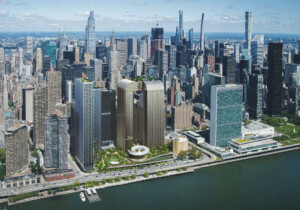One might think that the $1.9 billion overhaul of the United Nations Headquarters would be a multiple-stakeholder quagmire of Ground Zero proportions. However, as Michael Adlerstein, executive director of the U.N. Capital Master Plan, put it in a fascinating April 27 presentation, the consensus-based organization actually made it easier to push major decisions through, since the “joint stepping on of many toes” allowed various U.N. members to at least feel that they were being inconvenienced equally. And to alleviate the hefty price tag, the long-overdue renovations will be an object lesson in historical reuse, with 50 percent of interior fixtures and 95 percent of non-window exterior elements being refurbished.
First to be renovated is the Secretariat, which according to project curtain-wall consultant Robert Heintges was the first true curtain-wall tower in the U.S. Because the weight of the originally-specified insulating glass was too much for the sash mechanism of the double-hung windows within the unitized wall system, it had to be substituted with monolithic glass of such low performance that a reflective film was soon necessary, destroying the intended effect of transparency. Heintges’ new wall will restore this transparency, and to give the glass a historically accurate, monolithic appearance, a simple gray substrate is used instead of a double-skin facade. Because the new wall is also pressure-equalized and insulated, its performance will be boosted significantly.
Although the old curtain wall had to be almost completely replaced, the other quintessentially modern materials in the building (besides asbestos) will be restored: Vermont white marble, checkered terrazzo, brushed stainless steel, Naugahyde, and Formica. The original typical floor plan, with toilets perversely placed in the middle of the long west facade, blocking circulation and hogging the best views, will be adjusted to create a circulation loop around the core. To ensure that daylight is not blocked by walled private offices, open-plan workstations fill most of the area along the windows, with zones of walled offices placed at wide intervals. The other major interior adjustment described by John Gering, managing partner in charge for HLW International, involves punching holes in the robust structural beams to run mechanical, plumbing, and data services through, thus allowing a substantially higher ceiling and making room for a (previously missing) sprinkler system.
The presentation, organized by the Skyscraper Museum in partnership with the Architectural League and DOCOMOMO-New York/Tristate, covered other performance upgrades, as outlined by mechanical engineer Keith Fitzpatrick of Syska Hennessy Group. These include the use of CO2 sensors to control fresh air intake, rainwater harvesting, and other features that will reduce water and energy use by over 30 percent.
According to the U.N. master plan, all renovations are scheduled to be completed by 2013. In the meantime, staff have been moved to 1 million square feet of rented space in 10 separate buildings nearby, with the most important people and functions being relocated to a temporary structure on the North Lawn. When all is said and done, the oldest modern skyscraper in New York will also be one of the best-performing—proof that time can often redeem techno-utopianism’s heady ambitions.










